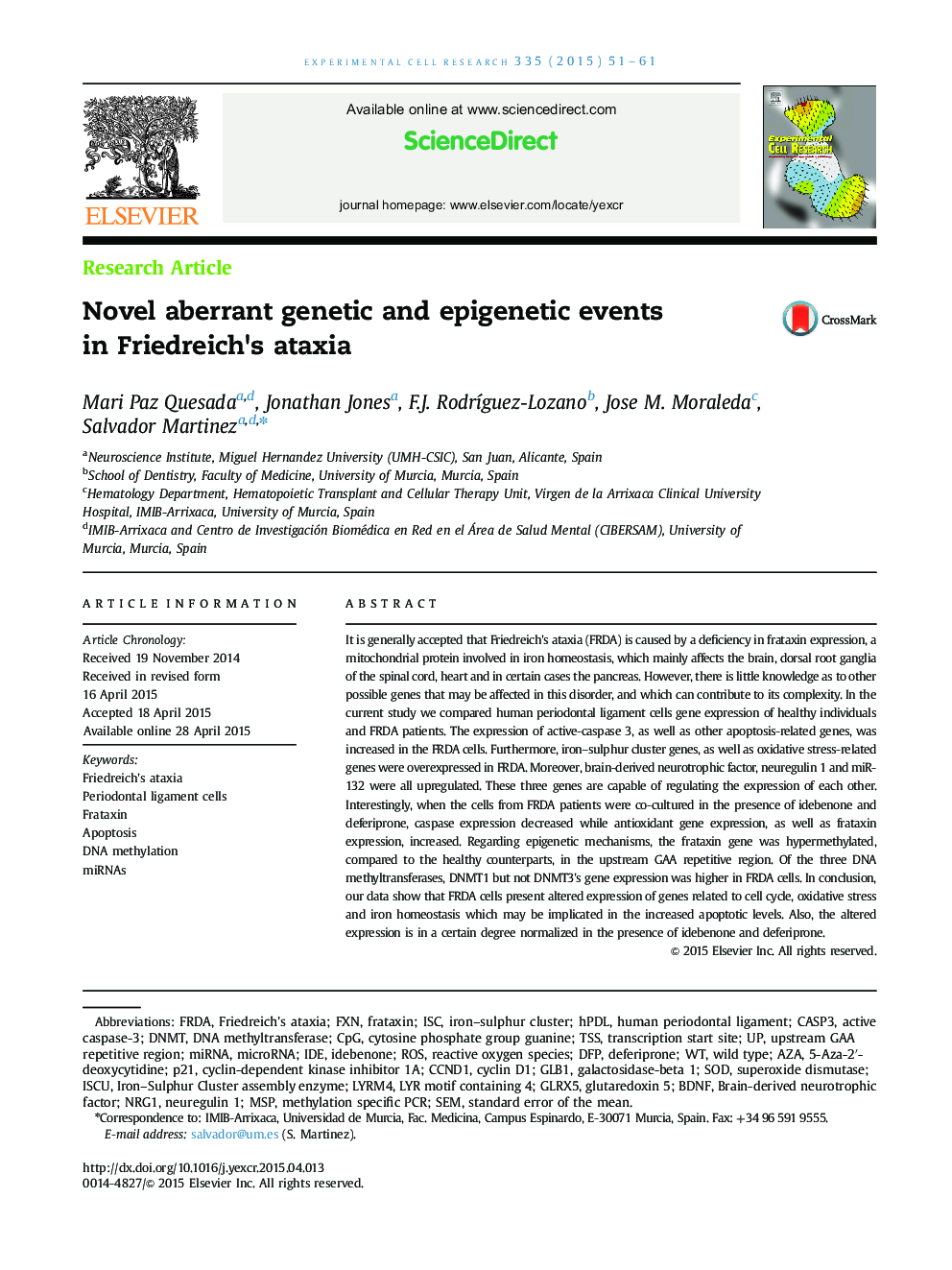| کد مقاله | کد نشریه | سال انتشار | مقاله انگلیسی | نسخه تمام متن |
|---|---|---|---|---|
| 2130189 | 1086536 | 2015 | 11 صفحه PDF | دانلود رایگان |
عنوان انگلیسی مقاله ISI
Novel aberrant genetic and epigenetic events in Friedreich׳s ataxia
دانلود مقاله + سفارش ترجمه
دانلود مقاله ISI انگلیسی
رایگان برای ایرانیان
کلمات کلیدی
AZAP21NRG1FRDACpGDFPISCDnmtCyclin D1MSPCASP3CCND1FxnIscUmiRNAsDeferiproneTSSGLB1HPDLstandard error of the mean.5-Aza-2′-deoxycytidine - 5-Aza-2'-deoxycytidineBDNF - BDNF یا فاکتور نورونزایی مشتقشده از مغز DNA methyltransferase - DNA متیل ترانسفرازmethylation specific PCR - PCR اختصاصی متیلاسیونROS - ROSIdebenone - ایده بیونIDE - اینجاApoptosis - خزان یاختهایIron–sulphur cluster - خوشه آهن گوگردtranscription start site - رونویسی شروع سایتSOD - سدPeriodontal ligament cells - سلول های رباط پریودنتالSuperoxide dismutase - سوکسوکس دیسموتازBrain-derived neurotrophic factor - فاکتور نوروتروفی مشتق شده از مغزFrataxin - فراتاکسینActive caspase-3 - فعال caspase-3human periodontal ligament - لگن پریودنتال انسانDNA methylation - متیلاسیون DNASEM - مدل معادلات ساختاری / میکروسکوپ الکترونی روبشیcyclin-dependent kinase inhibitor 1A - مهار کننده 1A کیناز وابسته به کینازMicroRNA - میکرو RNA MiRNA - میکروRNA، ریزآرانای، miRNAneuregulin 1 - نورونگولین 1wild type - نوع وحشیReactive oxygen species - گونههای فعال اکسیژن
موضوعات مرتبط
علوم زیستی و بیوفناوری
بیوشیمی، ژنتیک و زیست شناسی مولکولی
تحقیقات سرطان
پیش نمایش صفحه اول مقاله

چکیده انگلیسی
It is generally accepted that Friedreich׳s ataxia (FRDA) is caused by a deficiency in frataxin expression, a mitochondrial protein involved in iron homeostasis, which mainly affects the brain, dorsal root ganglia of the spinal cord, heart and in certain cases the pancreas. However, there is little knowledge as to other possible genes that may be affected in this disorder, and which can contribute to its complexity. In the current study we compared human periodontal ligament cells gene expression of healthy individuals and FRDA patients. The expression of active-caspase 3, as well as other apoptosis-related genes, was increased in the FRDA cells. Furthermore, iron-sulphur cluster genes, as well as oxidative stress-related genes were overexpressed in FRDA. Moreover, brain-derived neurotrophic factor, neuregulin 1 and miR-132 were all upregulated. These three genes are capable of regulating the expression of each other. Interestingly, when the cells from FRDA patients were co-cultured in the presence of idebenone and deferiprone, caspase expression decreased while antioxidant gene expression, as well as frataxin expression, increased. Regarding epigenetic mechanisms, the frataxin gene was hypermethylated, compared to the healthy counterparts, in the upstream GAA repetitive region. Of the three DNA methyltransferases, DNMT1 but not DNMT3׳s gene expression was higher in FRDA cells. In conclusion, our data show that FRDA cells present altered expression of genes related to cell cycle, oxidative stress and iron homeostasis which may be implicated in the increased apoptotic levels. Also, the altered expression is in a certain degree normalized in the presence of idebenone and deferiprone.
ناشر
Database: Elsevier - ScienceDirect (ساینس دایرکت)
Journal: Experimental Cell Research - Volume 335, Issue 1, 1 July 2015, Pages 51-61
Journal: Experimental Cell Research - Volume 335, Issue 1, 1 July 2015, Pages 51-61
نویسندگان
Mari Paz Quesada, Jonathan Jones, F.J. RodrÃguez-Lozano, Jose M. Moraleda, Salvador Martinez,